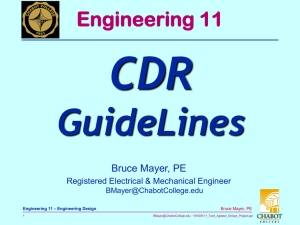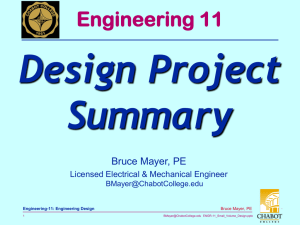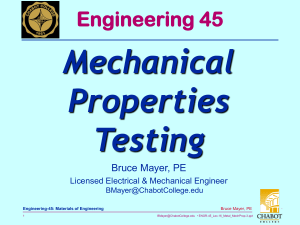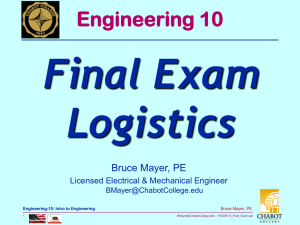Phase Diagrams (1) Engineering 45 Bruce Mayer, PE
advertisement
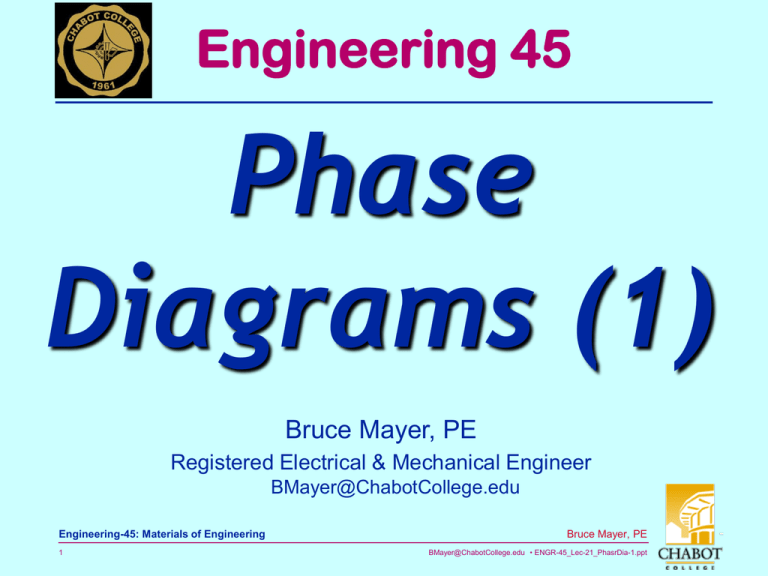
Engineering 45 Phase Diagrams (1) Bruce Mayer, PE Registered Electrical & Mechanical Engineer BMayer@ChabotCollege.edu Engineering-45: Materials of Engineering 1 Bruce Mayer, PE BMayer@ChabotCollege.edu • ENGR-45_Lec-21_PhasrDia-1.ppt Learning Goals – Phase Diagrams When Two Elements Are Combined, Determine the Resulting MicroStructural Equilibrium State For Example • Specify – a composition (e.g., wt%Cu - wt%Ni), and – a temperature (T) – a pressure (P) almost ALWAYS assume ROOM Pressure • Determine Structure Engineering-45: Materials of Engineering 2 Bruce Mayer, PE BMayer@ChabotCollege.edu • ENGR-45_Lec-21_PhasrDia-1.ppt Learning Goals.2 – Phase Dia. • Cont: Determine Structure – HOW MANY phases Result – The COMPOSITION of each phase – Relative QUANTITY of each phase Phase A Phase B Nickel atom Copper atom Engineering-45: Materials of Engineering 3 Bruce Mayer, PE BMayer@ChabotCollege.edu • ENGR-45_Lec-21_PhasrDia-1.ppt Definitions – Phase Systems Component Pure Constituent of a Compound • Typcially an ATOM, but can also be a Molecular Unit Solvent/Solute • Solvent Majority Component in a Mixture • Solute Minority Component in a Mixture System Possible Alloys Formed by Specific Components (e.g. C-Fe Sys) Engineering-45: Materials of Engineering 4 Bruce Mayer, PE BMayer@ChabotCollege.edu • ENGR-45_Lec-21_PhasrDia-1.ppt The Solid Solubility Limit • Add Sugar (Solute) to Water (Solvent) Engineering-45: Materials of Engineering 5 Solubility Limit 80 L (liquid) 60 L 40 (liquid solution i.e., syrup) 20 + S (solid sugar) 20 40 60 80 100 Co =Composition (wt% sugar) Pure Sugar 0 Pure Water Example: Water-Sugar 100 Temperature (°C) Solubility Limit Max Concentration of Solute that will actually DISSOLVE in a Solvent to form a SOLUTION Sucrose/Water Phase Diagram – Initially ALL the Sugar Dissolves – But after a Certain Amount, SOLID Sugar Starts to Collect on the bottom of the Vessel Bruce Mayer, PE BMayer@ChabotCollege.edu • ENGR-45_Lec-21_PhasrDia-1.ppt The Solid Solubility Limit cont. – 20 °C – 80 °C For 20 °C • Cast Right from 20C – Find Solid Sugar in Vessel at C0 = 63 wt% (liquid) 60 L 40 (liquid solution i.e., syrup) 20 0 6 + S (solid sugar) 75 20 40 60 63 80 100 Co =Composition (wt% sugar) • For 80C, Again Cast Rt – Find Solid Sugar in Vessel at C0 = 75 wt% • INcreased Temp INcreases Sol-Sol Limit Engineering-45: Materials of Engineering L Pure Sugar • At What wt% Sugar does the Sugar NO Longer Dissolve for Solubility Limit 80 Pure Water Sol-Sol Quantitative Example Temperature (°C) 100 Bruce Mayer, PE BMayer@ChabotCollege.edu • ENGR-45_Lec-21_PhasrDia-1.ppt Components & Phases Components The elements or compounds which are mixed initially (e.g., Al and Cu) Phases The PHYSICALLY and CHEMICALLY DISTINCT material regions that result from mixing (e.g., a and b below) • Aluminum Copper Alloy Engineering-45: Materials of Engineering 7 Bruce Mayer, PE BMayer@ChabotCollege.edu • ENGR-45_Lec-21_PhasrDia-1.ppt Effect of T & Composition (C0) Changing T can change No. of phases: path A to B. Changing C0 can change No. of phases: path B to D B(100,70) D(100,90) 1 phase Temperature (°C) 100 L 80 (liquid) 60 L liquid solution ( i.e., syrup) 40 + S (solid sugar) • Water Sugar System A(70, 20) 20 0 2 phases 2 phases 20 40 60 70 80 100 Co= Composition (wt% sugar)Bruce Mayer, PE Engineering-45: Materials of Engineering 8 0 BMayer@ChabotCollege.edu • ENGR-45_Lec-21_PhasrDia-1.ppt Phase Equilibria Consider the Cu-Ni Alloy System Ni Cu Crystal Structure electroneg r (nm) FCC 1.9 0.1246 FCC 1.8 0.1278 Both have the same crystal structure (FCC) and have similar electronegativities and atomic radii (c.f. Hume – Rothery rules) suggesting high mutual solubility. Copper and Nickel are, in fact, totally miscible in all Proportions Engineering-45: Materials of Engineering 9 Bruce Mayer, PE BMayer@ChabotCollege.edu • ENGR-45_Lec-21_PhasrDia-1.ppt Phase Diagrams Describes Phase Formation as a Function of T, C0, P This Course Considers • binary systems: 2 components • independent variables: T & C0 (P = 1atm in all Cases) • 2 phases: 1600 T(°C) 1500 L (liquid) • 3 phase fields: 1400 L L+ a a 1300 a (FCC solid solution) 1200 1100 1000 0 20 40 Engineering-45: Materials of Engineering 10 L(liquid) a(FCC solid soln) 60 80 – The Cu-Ni Phase Diagram 100 wt% Ni Bruce Mayer, PE BMayer@ChabotCollege.edu • ENGR-45_Lec-21_PhasrDia-1.ppt Phase Dia.’s: Phase No.s & Types Rule-1: Given T & C0 (for P = 1 atm) then Find • NUMBER & TYPES of Phases Present • Pt-A (1100C, 60wt-%) – 1 Phase → a; the FCC Solid Solution • Pt-B (1250,35) 1600 L (liquid) 1500 B(1250,35) Examples T(°C) 1400 1300 1200 – 2 Phases → L+a 1100 1000 Engineering-45: Materials of Engineering 11 a – Cu-Ni Phase (FCC solid Diagram solution) A(1100,60) 0 20 40 60 80 100 Bruce Mayer, PE BMayer@ChabotCollege.edu • ENGR-45_Lec-21_PhasrDia-1.ppt wt% Ni Phase Dia.’s: Phase Composition Rule-2: Given T & C0 (for P = 1 atm) then Find • The COMPOSITION (wt% or at%) for EACH Phase Example: C0 = 35 wt% Ni • At TA: – Only Liquid – CL = CO = 35 wt% Ni T(°C) TA 1300 TB 1200 TD 20 Engineering-45: Materials of Engineering 12 A tie line L (liquid) B D – Cu-Ni Phase a (solid) Diagram 3032 35 40 43 CL C0 50 Ca wt% Ni Bruce Mayer, PE BMayer@ChabotCollege.edu • ENGR-45_Lec-21_PhasrDia-1.ppt Phase Dia.’s: Phase Comp. cont. Example: C0 = 35 wt% Ni • At TD: – Only Solid (a-FCC) – Ca = C0 = 35 wt% Ni • At TB: – BOTH a and L – Ca = Csolidus 43 wt% Ni – CL = Cliquidus 32 wt% Ni Engineering-45: Materials of Engineering 13 T(°C) TA 1300 TB 1200 TD 20 A tie line L (liquid) B D a (solid) 3032 35 40 43 CL C0 – Cu-Ni Phase Diagram 50 Ca wt% Ni Note the Use of the IsoThermal “Tie Line” at TB to Find CL & Ca Bruce Mayer, PE BMayer@ChabotCollege.edu • ENGR-45_Lec-21_PhasrDia-1.ppt Phase Dia.’s: Phase Wt Fractions Rule-3: Given T & C0 (for P = 1 atm) then Find • The AMOUNT of EACH Phase in Wt-Fraction Example: C0 = 35 wt% Ni • At TA: – Only Liquid – WL = 1.00 & Wa = 0.00 (wt Frac’s) • At TD: – Only Solid – WL = 0.00 & Wa = 1.00 (Frac’s) Engineering-45: Materials of Engineering 14 T(°C) TA 1300 TB 1200 TD 20 A tie line L (liquid) B D – Cu-Ni Phase a (solid) Diagram 3032 35 40 43 CL C0 50 Ca wt% Ni Bruce Mayer, PE BMayer@ChabotCollege.edu • ENGR-45_Lec-21_PhasrDia-1.ppt Phase Dia.’s: Wt Fractions cont. Example: C0 = 35 wt% Ni • At TB: – BOTH a and L • Calc Wa,B & WL,B Using the INVERSE LEVER RULE WL TA 1300 A tie line L (liquid) B TB S 1200 TD 20 43 35 S 73wt % + R S 43 32 Engineering-45: Materials of Engineering 15 T(°C) R D a (solid) 3032 35 40 43 CL C0 – Cu-Ni Phase Diagram 50 Ca wt% Ni R = 27wt% Wa R +S Bruce Mayer, PE BMayer@ChabotCollege.edu • ENGR-45_Lec-21_PhasrDia-1.ppt Lever Rule Proof Sum of weight fractions: WL + Wa 1 Conservation of mass (Ni): C0 Wa Ca + WLCL Combine These Two Equations for WL & Wα A Geometric Interpretation moment equilibrium: WLR WaS Balance massXdist at Tip-Pt Engineering-45: Materials of Engineering 16 1 Wa solving gives Lever Rule Bruce Mayer, PE BMayer@ChabotCollege.edu • ENGR-45_Lec-21_PhasrDia-1.ppt Cooling Cu-Ni Binary Phase-Sys Phase Diagram forT(°C) L (liquid) Cu-Ni System → 1300 System L: 35wt%Ni 35 Characteristics: a:46wt%Ni 32 • BINARY → 2 components: Cu & Ni • ISOMORPHOUS →1200 Complete Solubility of one Component in Another – At least One Solid 1100 Phase-Field Extends 20 from 0 to 100 wt% Ni Engineering-45: Materials of Engineering 17 L: 35wt%Ni A B C 46 43 D36 24 L: 32wt%Ni a: 43wt%Ni E L: 24wt%Ni a:36wt%Ni a (solid) 30 35 C0 40 50 wt% Ni Bruce Mayer, PE BMayer@ChabotCollege.edu • ENGR-45_Lec-21_PhasrDia-1.ppt Ex: Cu-Ni Binary Cooling Consider 35 wt% Ni Cooled: 1300 °C → Rm-Temp Pt-A • 1.00 Liquid • 35 wt% Ni T(°C) L (liquid) 1300 L: 35wt%Ni a:46wt%Ni 18 35 1200 1100 20 B C 46 43 D36 24 • Tiny Amount of solida in Liq. Suspension Engineering-45: Materials of Engineering A 32 Pt-B on Liquidus – Liq → 35 wt% Ni – a → 46 wt% Ni L: 35wt%Ni L: 32wt%Ni a: 43wt%Ni E L: 24wt%Ni a:36wt%Ni a (solid) 30 35 C0 40 50 wt% Ni Bruce Mayer, PE BMayer@ChabotCollege.edu • ENGR-45_Lec-21_PhasrDia-1.ppt Ex: Cu-Ni Binary Cooling cont. Pt-C in 2-Ph Region • (43-35)/(43-32) = 0.727 Liquid – Liq → 32 wt% Ni – a → 43 wt% Ni T(°C) L (liquid) 1300 L: 35wt%Ni a:46wt%Ni • Small Liq Pockets in Solid Suspension • 1.00 a, @ C0 Engineering-45: Materials of Engineering 19 35 B C 46 43 D36 24 1200 L: 32wt%Ni a: 43wt%Ni E L: 24wt%Ni a:36wt%Ni a (solid) – Liq → 24 wt% Ni – a → 36 wt% Ni Pt E A 32 Pt-D on Solidus L: 35wt%Ni 1100 20 30 35 C0 40 50 wt% Ni Bruce Mayer, PE BMayer@ChabotCollege.edu • ENGR-45_Lec-21_PhasrDia-1.ppt NonEquilibrium Cooling Phases Diagrams are Constructed Under the Assumption of ThermoDynamic Equilibrium • i.e., All Phases have Formed Sufficiently Slowly to allow for HOMOGENOUS (same) Concentrations WITHIN ALL Phases In the Previous Example The Solid STARTS at 46 wt%-Ni (pt-B) and ENDS at 35 wt%-Ni (Pt-E) • Thus Solid particles that WERE 46Ni Had to CHANGE to 35Ni by SOLID STATE DIFFUSION But Solid-State Diffusion Proceeds Slowly • Rapid Cooling Can result in NonUniform Comp. Engineering-45: Materials of Engineering 20 Bruce Mayer, PE BMayer@ChabotCollege.edu • ENGR-45_Lec-21_PhasrDia-1.ppt NonEquil Cool → Cored Structure Ca Changes Composition Upon Cooling • First a to solidify has Ca = 46 wt%Ni • Last a to solidify has Ca = 35 wt%Ni Fast Cool Rate → Cored structure Slow Cool Rate → Equil. Structure First a to solidfy: 46wt%Ni Last a to solidfy: < 35wt%Ni Engineering-45: Materials of Engineering 21 Uniform Ca 35wt%Ni Bruce Mayer, PE BMayer@ChabotCollege.edu • ENGR-45_Lec-21_PhasrDia-1.ppt Mech Props → Cu-Ni System Recall Solid-Solution Strengthening 400 TS for pure Ni 300 TS for pure Cu 200 0 20 40 60 80 100 Cu Ni Composition, wt%Ni • Max As Fcn of C0 Engineering-45: Materials of Engineering 22 • Ductility (%EL,%AR) Elongation (%EL) Tensile Strength (MPa) • Tensile Strength, TS 60 %ELfor pure Cu %EL for pure Ni 50 40 30 20 0 20 Cu 40 60 80 100 Ni Composition, wt%Ni • Min as Fcn of C0 Bruce Mayer, PE BMayer@ChabotCollege.edu • ENGR-45_Lec-21_PhasrDia-1.ppt WhiteBoard PPT Work Problems 9.[5,6] • The Affect of PRESSURE on Phase Diagrams • Water Ice, Has at Least TEN, yes 10, Distinct Structural Phases – Phases form in Response to the PRESSURE Above The Ice Engineering-45: Materials of Engineering 23 Bruce Mayer, PE BMayer@ChabotCollege.edu • ENGR-45_Lec-21_PhasrDia-1.ppt Ice is Nice – Problem 9.5 Given Ice-I at −15C & 10atm → Find MELTING and SUBLIMATION PRESSURES • Note Typo in Book • Temperature needs to be –15 °C for this to work Engineering-45: Materials of Engineering 24 Bruce Mayer, PE BMayer@ChabotCollege.edu • ENGR-45_Lec-21_PhasrDia-1.ppt Ice is Nice P9.5a – Melt Temp At −15C Cast UPward to the Solid-LIQUID Phase Boundary 1000 Engineering-45: Materials of Engineering 25 • Find that Ice-I, when held at −15C, MELTS at about 1000 atm (~15000 psi, ~100 Mpa) Bruce Mayer, PE BMayer@ChabotCollege.edu • ENGR-45_Lec-21_PhasrDia-1.ppt Ice is Nice P9.5b – Sublime Temp At −15C Cast DOWNward to the Solid-VAPOR Phase Boundary • Find that Ice-I, when held at −15C, VAPORIZES at about 0.003 atm (~0.0002 psi, ~20 Pa) 0.003 Engineering-45: Materials of Engineering 26 Bruce Mayer, PE BMayer@ChabotCollege.edu • ENGR-45_Lec-21_PhasrDia-1.ppt Ice is Nice P9.6 P = 0.1 Atm At 0.1 Atm Cast RIGHTward to intercept the Sol-Liq and Liq-Vap Phase-Boundaries • Ice-I MELTS at 2 °C • Water BOILS at 75 °C 2.0 Engineering-45: Materials of Engineering 27 75 – i.e., the VAPOR PRESSURE of Water at 75 °C is 10% of Atm Bruce Mayer, PE BMayer@ChabotCollege.edu • ENGR-45_Lec-21_PhasrDia-1.ppt


